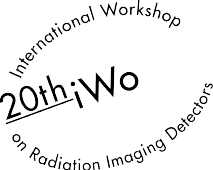Speaker
Description
In this study, an organic polymer-based photodetector was investigated as a candidate for the indirect-type X-ray detector. Organic photodetectors fabricated with polymers have the advantage of being able to apply flexible substrates and simple processes while reducing manufacturing costs. In order to enhance the performance of the photodetector, conjugated polymer PBDB-T1) was selected as a p-type material instead of P3HT2) commonly used as a p-type material to form a bulk-heterojunction with n-type PC70BM3) (Fig. 1a). Compare with P3HT, PBDB-T has more alkyl chain and quinoid character. The alkyl chain facilitates the intermolecular covalent bonds and helps to form the percolation paths with n-type material. Quinoid helps electrons migrate from p-type to n-type and leads to high short circuit current in the photodetector. Absorption spectra of the thin film with 1:1 blending ratio of P3HT: PC70BM and different blending ratios of PBDB-T:PC70BM were measured (Fig. 1b). PBDB-T:PC70BM-blended thin film showed higher absorption in the entire visible-light range and the absorption spectrum of PBDB-T:PC70BM was well-matched to CsI(Tl) emission spectrum. The organic photodetectors were fabricated with different blending ratios and spin-rates of PBDB-T:PC70BM. The detector fabricated at the condition of PBDB-T:PC70BM = 2:3 blending ratio and spin rate of 1,100 rpm showed the highest collected current density (CCD) and highest sensitivity which were 434.14 nA/cm2 and 3.25 mA/Gy*cm2, respectively (Fig. 1c). This is 152% enhancement of CCD and 189% enhancement of sensitivity than the common P3HT:PC70BM photodetector.




